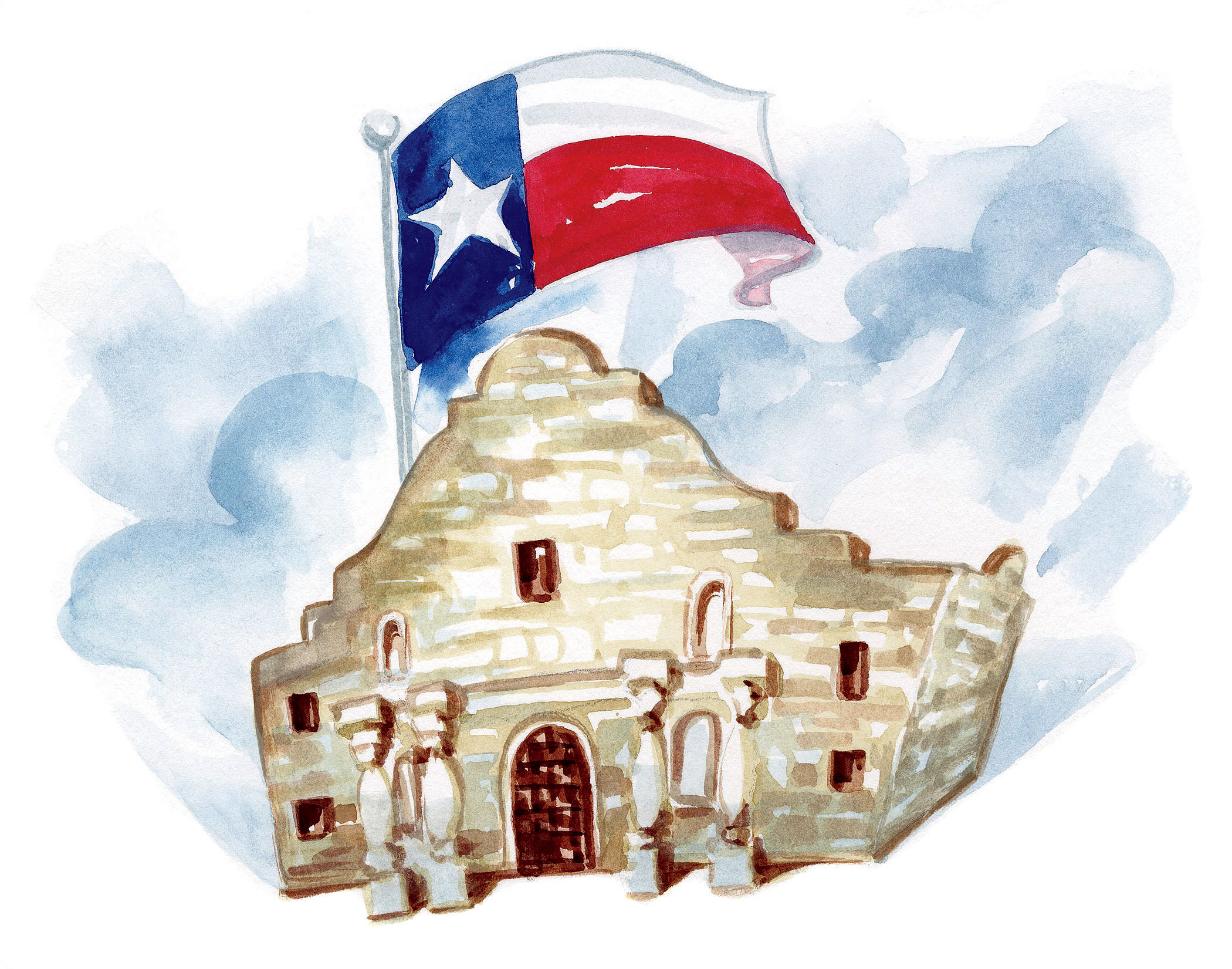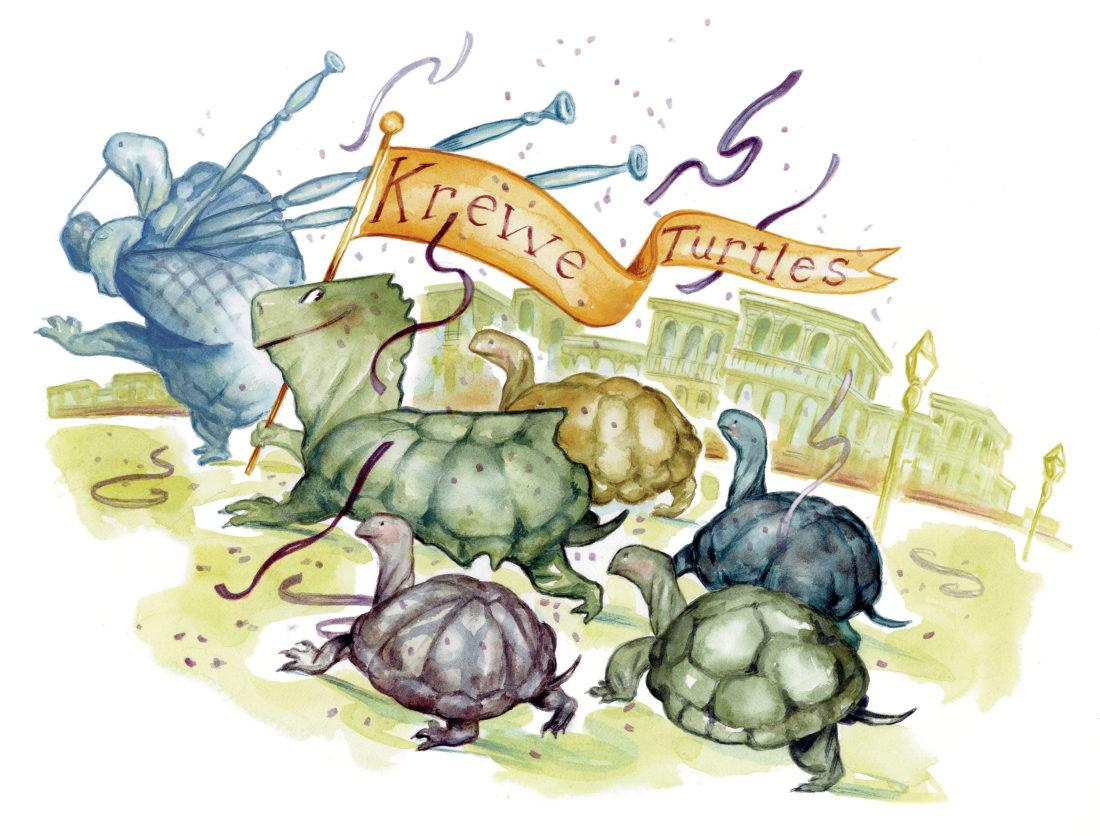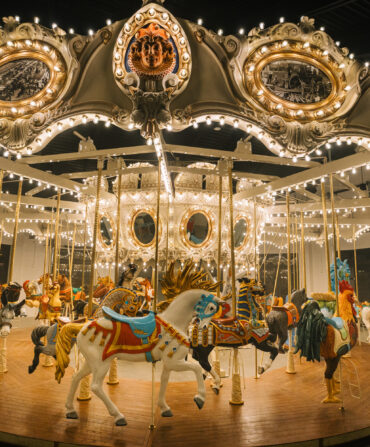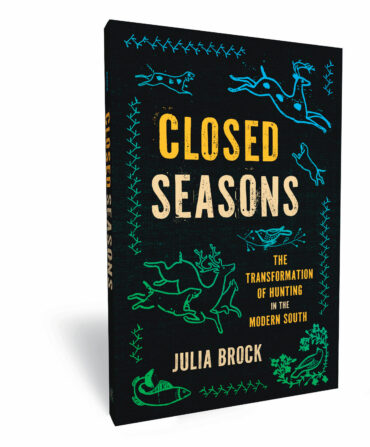PARADE
Louisiana
Let the Good Times Crawl
In addition to a potent milk punch and the country’s preeminent bananas Foster, the team at Brennan’s—the pink-and-green-clad culinary grande dame on Royal Street in the heart of New Orleans’ French Quarter—makes a standout turtle soup. Paddling around in the courtyard fountain, though, are ten red-eared sliders guaranteed never to see the inside of a stew pot. Not only because they’re the wrong kind (Brennan’s chefs use snappers), but also because these turtles are family. When Ralph Brennan purchased the aging restaurant from his cousins in 2013 and began a top-to-bottom renovation, the turtles decamped from their decades-long home to temporary lodging in the backyard of chef Haley Bittermann. As the restaurant prepared to reopen in late 2014, Brennan and company decided that “the mothas and the othas,” as the turtles are known—they’re named for the mother sauces of French cuisine and five other classic Crescent City sauces—needed a proper reintroduction. In New Orleans, what else could “proper” mean than a parade? Brennan’s employees spent months designing and building the first Krewe of Turtles floats in 2015. Led by bagpipers and a police escort, Hollandaise, Béchamel, Espagnole, and the rest made their way through the French Quarter, ending at the restaurant. You can join the fourth-annual parade on May 12, and stick around for the turtles’ official pardoning as well as complimentary grasshoppers and dessert in the courtyard. Can’t make it? Follow @brennansturtles on Twitter to see what Remoulade and Mignonette are up to today. brennansneworleans.com
OPENING
Alabama
Past Due
“The history of Montgomery mirrors the history of our nation,” says Kiara Boone, a deputy program manager at the Equal Justice Initiative (EJI), the social advocacy group behind the Legacy Museum: From Enslavement to Mass Incarceration. The new museum explores racial injustice in the United States from slavery to Jim Crow to today’s justice-system struggles, with a particular focus on Montgomery’s own tumultuous history. Visitors entering the downtown property—an 11,000-square-foot space on the site of a former slave warehouse—will experience what it might have felt like to await fate through recordings of historic first-person accounts. Employing film, fine art, sculpture, music, and groundbreaking research, the museum, which is scheduled to open on April 26, also tackles the racial terrorism of lynching with unflinching and unprecedented honesty. EJI compiled startling new statistics on the number of African Americans killed by mobs across the South from 1877 to 1950—more than four thousand. Its findings are the foundation of the National Memorial for Peace and Justice, which opens simultaneously with the museum. An easy fifteen-minute walk from downtown, the memorial sits on six acres overlooking the city. Eight hundred large steel sculptures, one for each county in the United States where a lynching occurred, are dedicated to the victims. “The memorial offers a chance for people to engage with this history of violence in a way that is both intellectual and emotional,” Boone says. “The same way you would leave the 9/11 Memorial or the Holocaust Museum, we want people to leave here with a reckoning.” museumandmemorial.eji.org
GARDEN
Arkansas
Spring Forward
The Arkansas-bred landscape designer P. Allen Smith tends his “rich spot of earth”—a six-hundred-acre expanse in Roland called Moss Mountain Farm—with Jeffersonian zeal. Every Thursday and Friday through June 29, Smith, who hosts three popular TV garden shows, welcomes inquiring green thumbs to his private retreat overlooking the Arkansas River as part of the farm’s Spring Lunch Tour series. Stroll through the riverfront terraced garden, the ornamental vegetable patch (this year, Smith is experimenting with carrots), and the heritage English-style rose garden, and the designer’s devotion to both preservation and experimentation quickly becomes clear. “I use the farm as a canvas,” he says. “It is a laboratory—a sort of living studio for developing new design concepts and plants.” For showy blooms, late April is your best bet, Smith advises. Though you’ll most likely miss the daffodils then—he plants upwards of four hundred thousand bulbs on Daffodil Hill—you’ll catch both the tulips and the early roses. (Moss Mountain is also renowned for its collection of antique Noisette roses, the first rose developed on American soil.) Poultryville—home to the property’s sixty rare and endangered breeds of chicken, geese, and turkey—is the last stop on the circuit before lunch in Grange Hall, the farm’s barn turned dining space. Pro tip: Check the schedule for bonus once-a-month Saturday tours for a chance to glean gardening advice from Smith in person. pallensmith.com
LITERATURE
Florida
Storytelling Squared
Given the name of Tallahassee’s Word of South festival (April 13–15), it’s no surprise that president Mark Mustian made up his own to describe its offerings. “I call it a mu-aush-up,” he says—a musician-author mash-up in which two storytelling forms come together in live performances. “You won’t see these shows anywhere else. They’re unique.” One past session threw Mississippi blues dynamo Eden Brent together with fellow Delta native and sharp-witted author Julia Reed on the subject of fried chicken. They took turns praising the Southern standard—Reed with prose, Brent with soulful song and keyboard. “That duo had folks rolling, but we leave what the artists do up to them, so it’s always different,” Mustian says. This year, the Southern-lit lion Rick Bragg and foodways expert John T. Edge are on the list to rep the written word, with Tedeschi Trucks Band and Susanne Vega (among others) bringing the music. In addition to the pairings, traditional concerts and readings from every genre occupy the gathering’s seven stages and various tents scattered around Cascades Park. Word of South’s cross-pollination of creativity draws audiences up to twenty thousand. But it also enriches the lineup. “The artists say the mu-aush-ups really expand their boundaries,” Mustian says. As well as their vocabularies. wordofsouthfestival.com

Tim Bower
PHOTOGRAPHY
Georgia
Inspiration Highway
Willie Nelson sang about it. Jack Kerouac wrote about it. Susan Sarandon and Geena Davis took it to extremes in Thelma and Louise. Beginning with the advent of the automobile, the great American road trip has captured the creative consciousness of a nation of artists. The tradition had an especially powerful influence on post–World War II photographers, and a new exhibit at Savannah’s Jepson Center, The Open Road: Photography and the American Road Trip (May 25–September 3), explores the work of nineteen lensmen who looked to ribbons of asphalt as their muse. “The exhibition begins with photographer Robert Frank and his seminal 1958 series, The Americans, and moves through present day,” says assistant curator Erin Dunn. Displayed chronologically, the show’s hundred photos tell the story of a nation—potholes and all. One of Dunn’s favorite photographs is Joel Sternfeld’s McLean, Virginia, December 1978. The startling image shows a fireman shopping for pumpkins at a farmers’ market while a house burns on a hill above him. “It turns out the fireman was participating in a training program, and he was on a break,” Dunn says. “But you wouldn’t know that initially. Sternfeld didn’t. Like many of the show’s images, it was serendipitous.” telfair.org
FESTIVAL
Kentucky
Make Good
When the fourth-generation distiller and the founder of Maker’s Mark Bill Samuels, Sr., set out to build a better bourbon in 1953, he famously burned the family recipe, and with the help of some knowledgeable friends—Jerry Beam, Ed Shapiro of Heaven Hill, Pappy Van Winkle, and “Hap” Motlow of Jack Daniel’s—painstakingly worked to develop the smoother spirit that’s on shelves today. It was his wife, Marge, though, who gave the brand its name, label, and signature red wax. The bottles are still hand dipped. To celebrate artists from around the South who share a similar commitment to craftsmanship, the company hosts the annual Maker’s Mark Handcraft Festival (April 14). Wares from nearly fifty vendors include jams and jellies, local honey, textiles, jewelry, fine art, bourbon-barrel furniture, custom leather goods, even gourmet dog treats. Spread across portions of the distillery’s thousand-acre campus in Loretto, the festival also assembles a fleet of Kentucky food trucks; Lexington’s J. Render’s BBQ always pulls in a crowd for its brisket and homemade banana pudding. In addition to live bluegrass, your ticket gets you three fingers of Maker’s neat, and the distillery’s on-site restaurant and bar, which debuted last year, is also open. Try the house cocktail—a mix of Maker’s Mark, Ale-8 One, lemon juice, simple syrup, and bitters. The current master distiller, Greg Davis, along with the Samuels family, will be on hand to sign bottles for fans. And the distillery is open for self-guided tours; the gift shop, too, for those wanting to dip their own bottle in that famous red wax. makersmark.com
DRINK
Maryland
An Irish Hello
In 1759, when Arthur Guinness acquired a brewery at St. James’s Gate in Dublin, he was thinking long term: The lease extended nine thousand years. But it took less than sixty for Guinness to start exporting barrels of porter—the forerunner of its celebrated stout—to U.S. shores (the first shipment arrived in Charleston, South Carolina). America’s love affair with the famed Irish brew is almost as old as the country itself, and this summer, there will be a new place in which to revel in it: the $80 million Guinness Open Gate Brewery & Barrel House, in Relay, a suburb outside Baltimore. The five-story brewery occupies sixty-two acres on the site of a former Seagram’s distillery and includes a taproom, a beer garden, and a restaurant. “We’re trying to break out of that mold in America of just being a single-beer company,” says the marketing manager, Oliver Gray, referring to the signature stout. “We want to show off our brewing cred.” The original will still be brewed in Dublin, while the new American outfit will be geared toward experimentation. In this pursuit, the company has hired a number of U.S. brewmasters (Hollie Stephenson, formerly of Asheville’s Highland Brewing, for example). Paying homage to Guinness’s pre–Industrial Revolution beginnings, Stephenson and crew plan to focus on barrel aging some of the new suds. That means wood, buster. In Arthur’s day, there was no such marvel as stainless steel. newguinnessbrewery.com
GARDEN
Mississippi
Growing Reputation
Despite leading the state in population growth, Oxford isn’t resting on its laurels—or its tulips and daffodils. (More than twenty thousand bulbs spring up on the University of Mississippi campus grounds each March.) Recognizing that its green spaces are a big attraction, the city invites people to put down roots (literally) during its annual Landscaping Camp (May 25–27)—a combo of how-to classes and garden tours led by a team of professional gardeners helmed by Jeff McManus, the university’s director of landscape services, whose meticulous management of Ole Miss’s grounds is credited with its many “prettiest campus” honors and has made him a sought-after speaker. This year, campers will find a packed schedule, which includes exploring the tangles of wisteria at William Faulkner’s home, Rowan Oak, and discovering how the vine factored into his fiction. The camp goes beyond garden-variety tips: McManus divulges his pro pruning technique, one he has inspired his staff to use on a grand scale. “He and his team don’t use electric trimmers on Ole Miss’s shrubs; they hand shape the vast majority for a natural look,” says Rosie Vassallo of the Oxford-Lafayette County Chamber of Commerce. “That’s the kind of dedication he instills.” oxfordms.com
STYLE
North Carolina
Passion for Fashion
In the spring of 2011, Oscar de la Renta hosted a runway show at Charlotte’s then recently launched Mint Museum Uptown location, and though the famed designer would never return to the Queen City—he died in 2014—his work soon will with the opening of the traveling exhibit The Glamour and Romance of Oscar de la Renta on April 29. Part of the Mint’s yearlong celebration of its acclaimed fashion collection, the exhibition serves as the glittering backdrop for the museum’s Coveted Couture Gala (April 28). The annual black-tie fund-raiser is cochaired this year by Laura Vinroot Poole and her husband, Perry, owners of the high-end Charlotte clothiers Tabor, Poole, and the venerable Capitol, which marks its twentieth anniversary in 2018. The gala’s four hundred attendees will get an early look at the exhibit, which showcases original sketches; editorial photography from various fashion magazines; and fifty ensembles pulled from de la Renta’s corporate and personal archives, the Pierre Balmain collection (de la Renta directed the French house from 1993 to 2002), and couture-stuffed private closets. Gala guests will also have a chance to pick up in-person style pointers from André Leon Talley, the exhibit curator and former American Vogue editor at large. mintmuseum.org
GARDEN
South Carolina
Old-Time Revival
Columbia’s Hampton-Preston House and its grounds—built in 1818 on the corner of Pickens and Blanding Streets—survived General Sherman, a stint as the governor’s mansion, and four turns as various institutes of higher learning. But commercial real estate development in the late 1940s nearly did the place in. Since 2012, though, in the hands of just two full-time gardeners and a dozen volunteers, the once overrun grounds have come back to life season by season. And on May 19, Historic Columbia will celebrate the reopening of the renovated garden to the public, coinciding with the two hundredth anniversary of Hampton-Preston’s construction. “The four acres are divided into garden rooms with a foundation of boxwood around a fountain, saw palmettos around the edges, and plenty of hydrangeas and roses,” says Robin Waites, the executive director of Historic Columbia. For plantings in the front and rear, gardeners thumbed through antique nursery catalogues to discover historically accurate varieties—deep red Camellia japonica ‘Anemoniflora’ dating to 1814; lilac evergreen azaleas from the 1830s. The backyard trails wind through ginkgo, chinaberry, and monkey puzzle trees, nods to the original owners’ global travels. “Historically, as now, the home had a public entrance for people to feel welcome to come through the gate,” Waites says, “allowing them to spend time in a beautiful green space in our city’s center.” historiccolumbia.org
OUTDOORS
Tennessee
Bloom and Grow Forever
With monikers straight out of Tolkien—bishop’s-cap, jack-in-the-pulpit, lady’s slipper—the wildflowers of the Great Smoky Mountains National Park are every bit as enchanting to say as to see. It’s a popular opinion, judging by the hundreds of petal peepers who make their way to Gatlinburg for the annual Spring Wildflower Pilgrimage (April 24–28). The park is home to more than fifteen hundred species of flowers that burst into bloom each spring, traveling uphill as the weather warms. Ephemerals such as trillium (the mountains nurture ten varieties) open the show. To spot the most color, join one of the pilgrimage’s guided hikes. There are tours for all fitness levels—just bring a light rain jacket; the hikes are rain or shine, and weather in the Smokies this time of year is fickle. Tickets go fast, but if you miss out, don’t worry. The park’s second act lasts through June with vivid displays of mountain laurel, rhododendron, and native azalea lining nearly every trail. wildflowerpilgrimage.org

Tim Bower
ANNIVERSARY
Texas
Party Like It’s 1718
“Demographers say, if you want to see what our country might look like in the future, look to San Antonio,” says assistant city manager Carlos Contreras. “It’s home to a whole mix of cultures who have figured out how to live together and prosper.” But this year, the city is looking to its past—and not just the famous thirteen-day battle for the Alamo. Throughout its 2018 Tricentennial, the city, which was founded on May 1, 1718, as a Catholic Spanish mission, will honor its additional 299 years and 352 days of history. Though there are more than seven hundred events peppered throughout the year, the Tricentennial mission comes into sharpest focus during Commemorative Week (May 1–6)—six days of art, music, and history. Things kick off with candlelit sunset services in the city’s main square on May 1’s Day of Reflection. Arts for All (May 4) offers free admission to museums and galleries and the unveiling of new public art installations, including Common Currents, an innovative new exhibition that tasked three hundred artists with each creating a work inspired by a single year of San Antonio history. The city will also break ground on the San Pedro Creek project (May 5), which reimagines the public spaces around the historic creek—site of the first of the city’s UNESCO-designated missions. Here, the past, present, and future of San Antonio collide. sanantonio300.org
OPENING
Virginia
Inn the Know
The building that now houses the Blackburn Inn in Staunton used to be more like the Hotel California—back when it was a jail, checking out wasn’t an option. The new owners are hoping its transformation into a forty-nine-room boutique hotel will have guests wishing they never had to leave. The inn’s spring opening is more than a decade in the making; the structure was designed by architect Thomas Blackburn, a Jefferson protégé, and built in 1828, so carefully restoring its historic details was paramount. English master masons repaired the exterior’s massive Ionic columns brick by brick. But the inn isn’t stuck in yesterday; guest rooms—including a penthouse with a rooftop patio providing views of the town and the surrounding Shenandoah Valley—are dressed up with modern amenities, sleek furnishings, and contemporary fabrics. There’ll also be work from local artists at an on-site gallery, outdoor performances on the expansive lawn, and a bistro wine list stocked with Virginia vintages. blackburn-inn.com
ART
Washington, D.C.
Stamp of Approval
The political drama behind a single stamp in the Smithsonian National Postal Museum’s Beautiful Blooms: Flowering Plants on Stamps exhibit (through July 14, 2019) proves that something small can create a big stir. The 1966 Beautification of America stamp, a diffused image of cherry blossoms on the Washington Mall, celebrated passage of the Highway Beautification Act, a piece of legislation championed by Lady Bird Johnson to make America’s most public spaces—the then still-new interstate system—more pleasant places. “A little beauty,” Johnson said, “something that is lovely, I think, can help create harmony, which will lessen tensions.” Seems simple enough, right? Nope. “The act limited billboards on interstates and was fought tooth and nail by the billboard industry,” says exhibit curator Calvin Mitchell. That contentious first stamp, dubbed the Lady Bird stamp, was followed by four more, intended to drum up support for the act. Despite the fiery debate the Lady Bird stamps sparked, they are by no means the flashiest in the exhibit—in fact, Mitchell points out, their colors are quite subdued compared with the rest. Thirty-three sketches, vibrant finished artworks of massive magnolia blossoms and immense irises, and the resulting stamps are all on display, joined by live plants from the Smithsonian Gardens—a combination Johnson would no doubt find delightful. postalmuseum.si.edu
FOOD
West Virginia
Blue Ridge Bounty
Ramps: Top chefs love them, and mountain natives revere them. The elusive wild onions thrive in the rich soil of the Appalachian Mountains at elevations between three and five thousand feet and appear for about a month between the end of April and early June. To get your hands on a bunch, you’ll have to lace up your hiking boots—or follow your nose to StinkFest (April 21). The annual Huntington event, celebrating the famously pungent allium, is hosted, fittingly, by the folks at the Wild Ramp. Founded in 2012, the year-round nonprofit produce market is located in Huntington’s historic Old Central City and works with a roster of area farmers, selling everything from yams to yak—yes, yak; venison and bison, too. Eggs, dairy, honey, you name it. But only the market’s eponymous edible gets its own festival, during which local vendors sell ramp-centric dishes (ramp potato soup, ramp-and-bacon-studded biscuits, and more). To take home a bundle of raw ramps, visit Crawford Family Farm stand. The Crawfords are regulars, so if you miss StinkFest, you’ve still got time—just don’t put it off too long. wildramp.org








